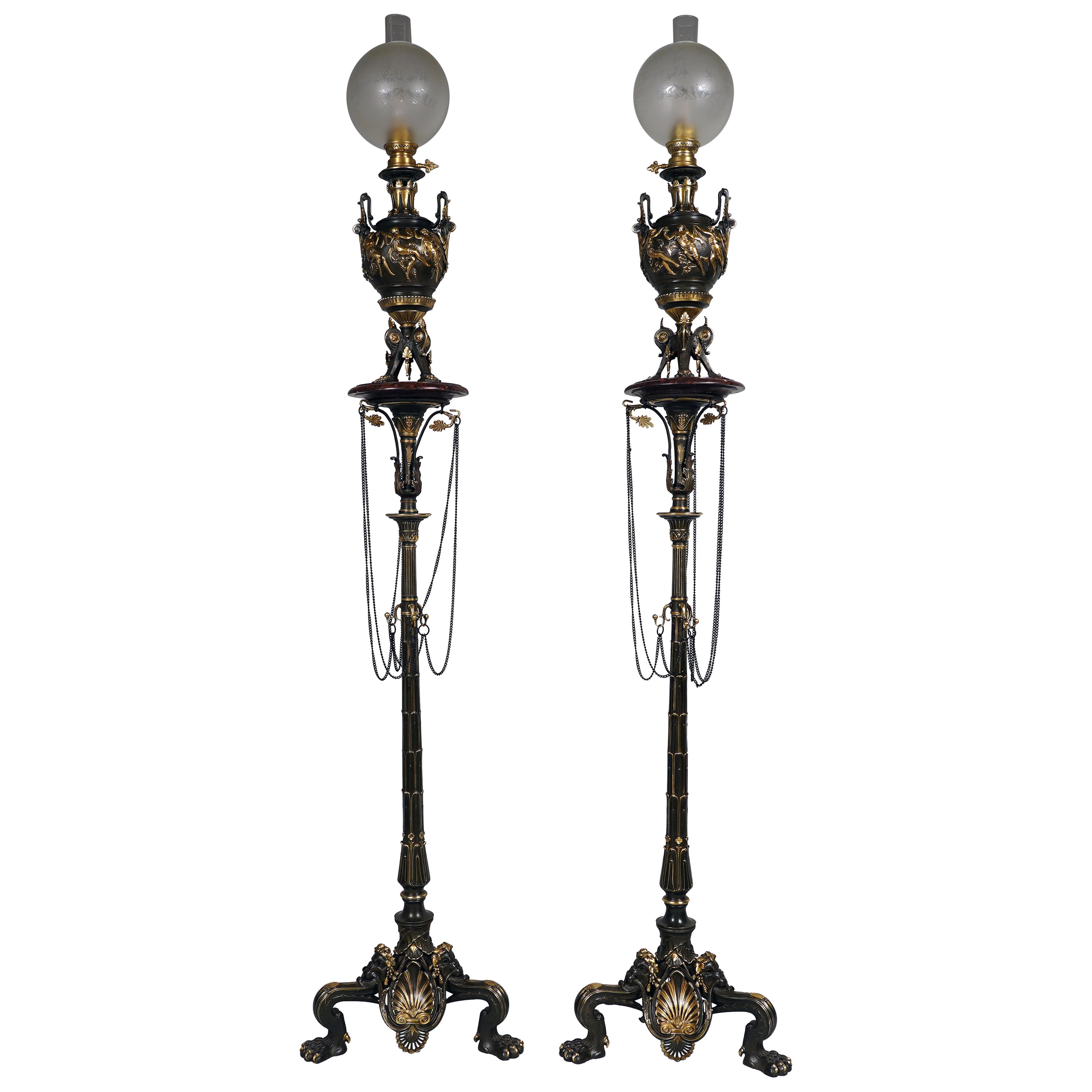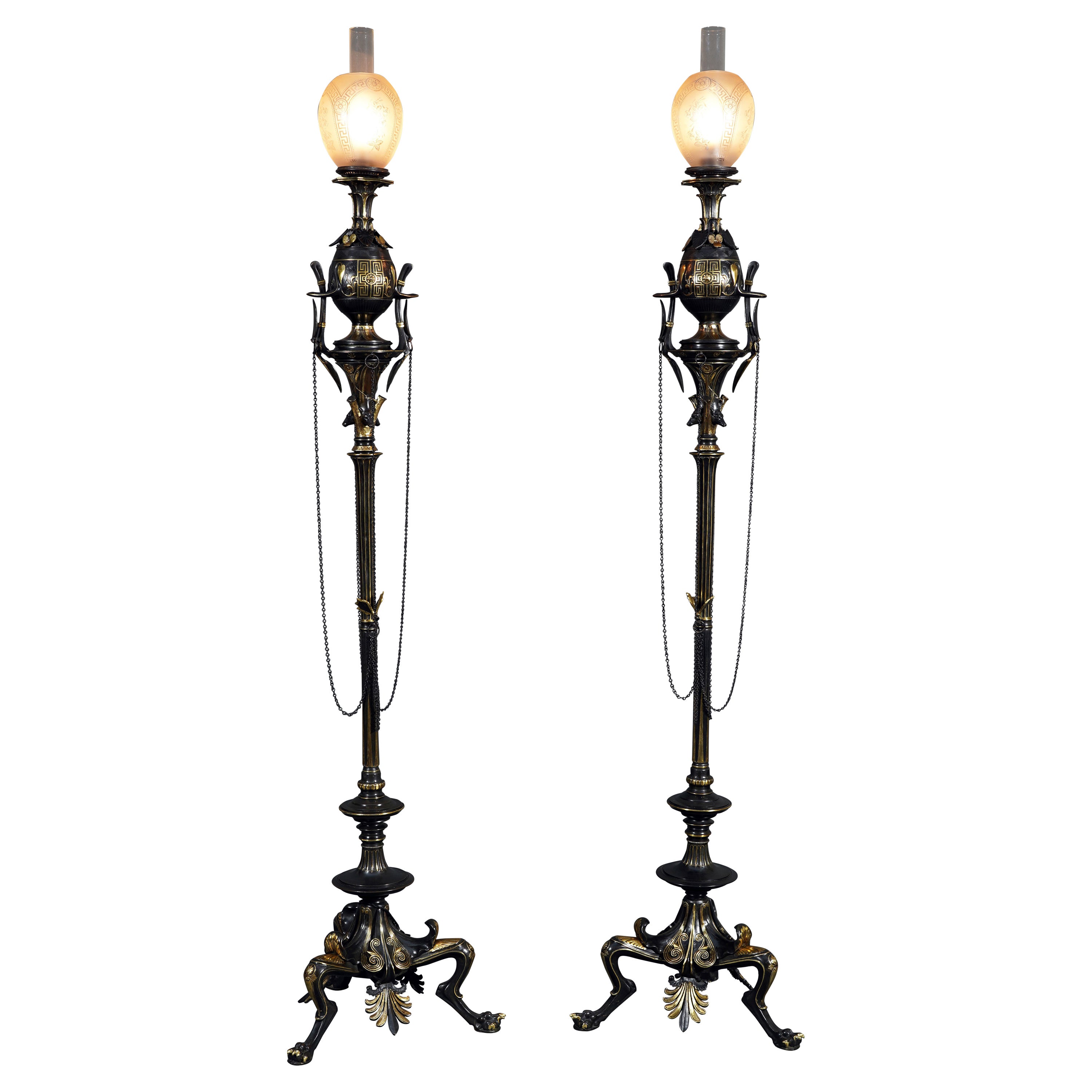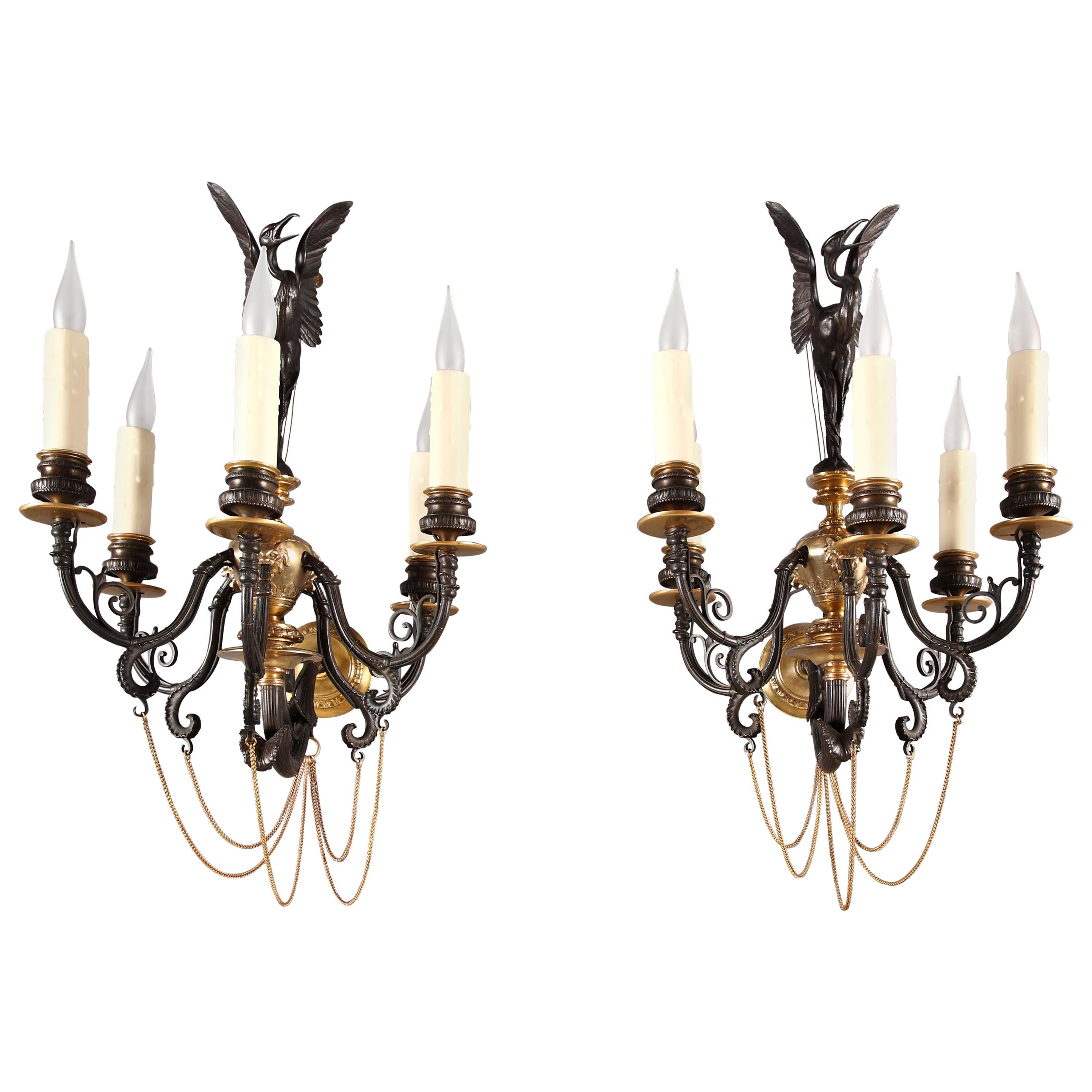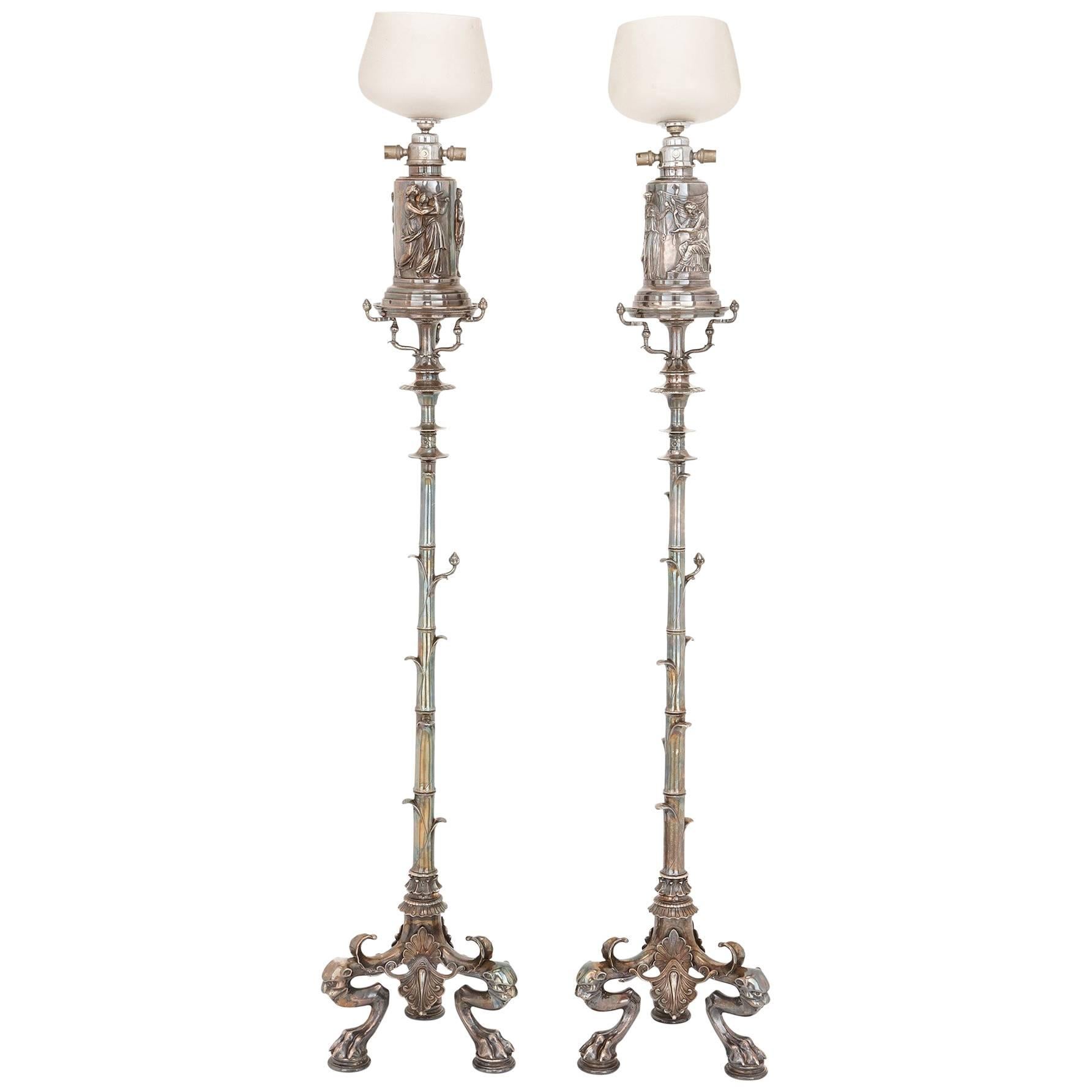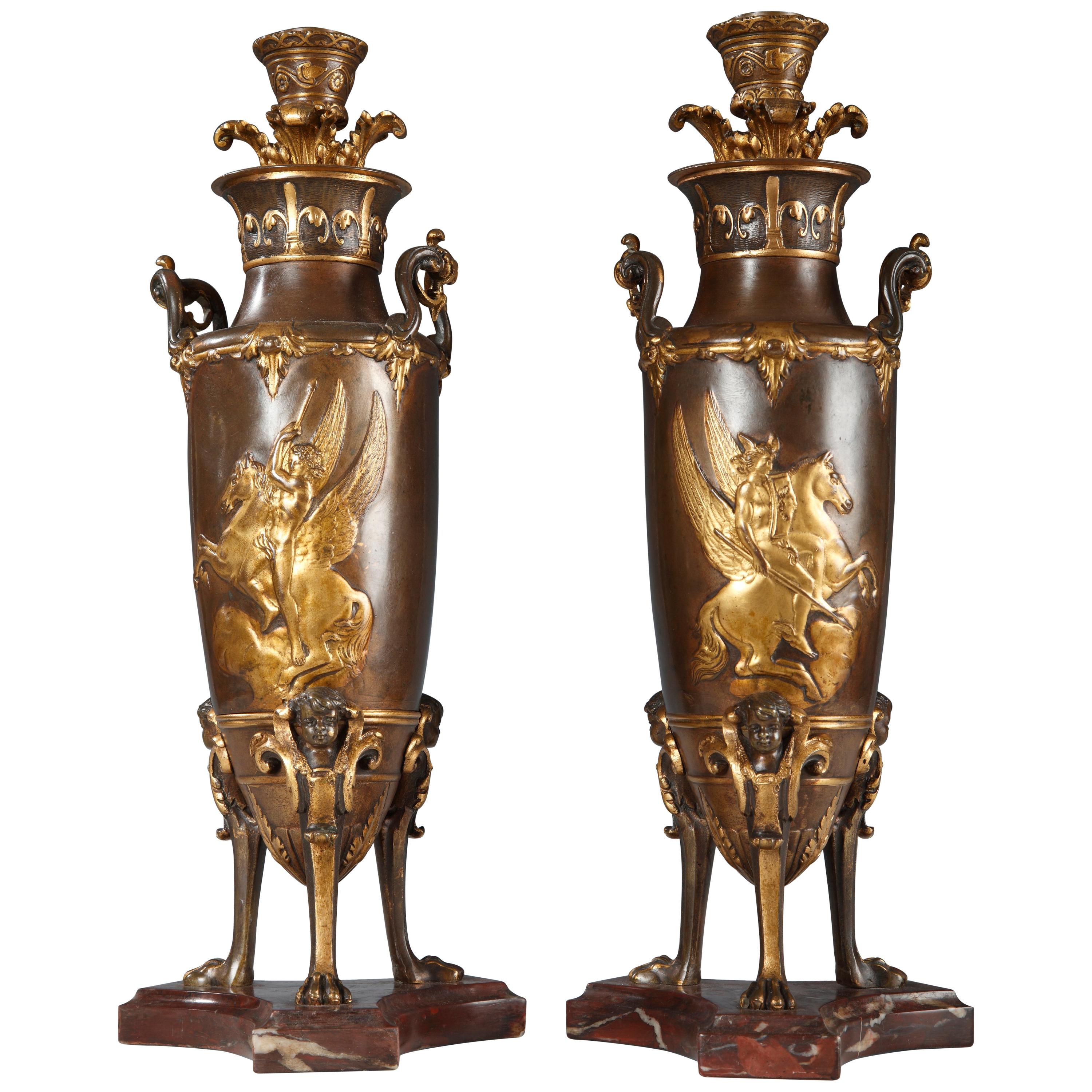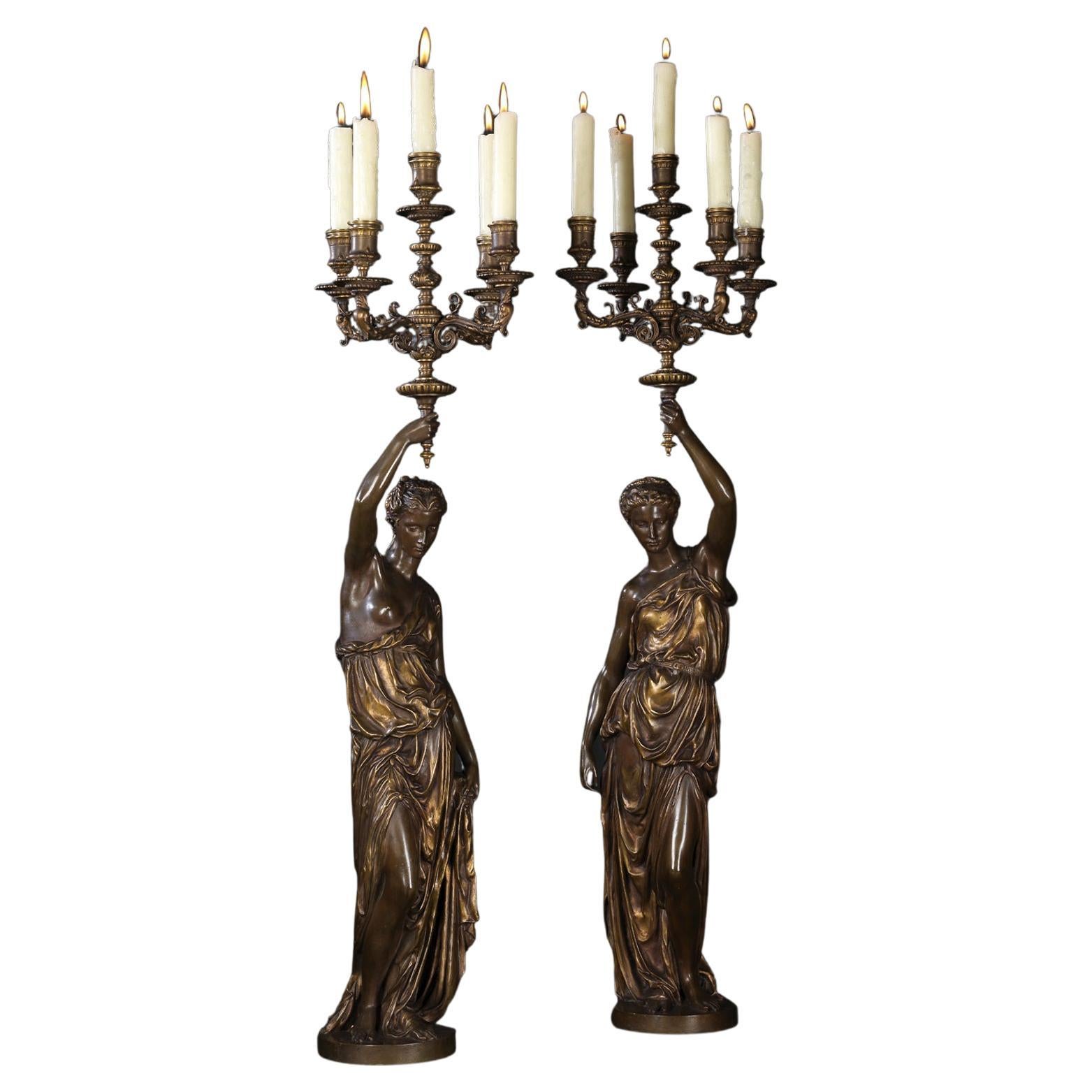Items Similar to Pair of Neo-Greek Bronze Floor Lamps by F. Barbedienne, France, circa 1860
Want more images or videos?
Request additional images or videos from the seller
1 of 10
Pair of Neo-Greek Bronze Floor Lamps by F. Barbedienne, France, circa 1860
About the Item
Height without/with lampshade : 168/185 cm (66,1 / 72,8 in.) ; Base : 43 x 43 cm (16,9 x 16,9 in.)
Beautiful pair of neo-Greek floor lamps in bronze with double patina, composed of cylindrical lamps, decorated on the body with a rotating frieze representing women dressed in the Antique style weaving and spinning, surmounted by lampshades with cut sides in red pleated silk with golden braid.
They are placed on pedestals from which hang thin chains attached to the slender shaft decorated with stylized leaves and flowers, resting on a tripod base decorated with large palmettes and ending in lion’s paws.
The stylistic repertoire used here, composed in particular of palmettes, masks, and nymphs, evokes Greek Antiquity, as does the reuse of forms of furniture and objects such as tripods and antique vases.
The rediscovery in the 18th century of the archaeological remains of Pompeii and Herculaneum allowed artists of all disciplines to draw inspiration from Antiquity while reinterpreting it.
This trend did not fade and, in the 19th century, many personalities fitted out their interiors with neo-Greek furniture, as was the case for the Maison Pompéienne built in 1856 by the architect Alfred Normand (1822-1909) for Prince Napoleon, or Empress Eugénie who bought from the Maison Barbedienne pedestals inspired by antique tripods.
Related work :
Pedestal model presented by Maison Barbedienne at the Universal Exhibition in Paris in 1855. On this occasion, Empress Eugénie bought it for her bathroom in the Château de Saint-Cloud. This model pleased the Empress so much that she ordered two other pairs in 1858 for her boudoir in the palaces of Compiègne and Fontainebleau. (see photo attached)
Photo showing a floor lamp similar to ours in Empress Eugénie’s bedroom in the Château de Compiègne (Oise), in Architecture intérieure et Décoration en France des origines à 1875, Jean Feray, Editions Berger-Levrault, 1988, p. 355 (see photo attached).
Biography :
Born in 1810, Ferdinand Barbedienne started at n°30 boulevard Poissonnière in Paris one of the most famous 19th century artistic bronze casting companies. He died in 1892. In addition to his personal production, he worked for famous artists such as Auguste Clésinger, Albert-Ernest Carrier-Belleuse and Louis Barrias. At the London Universal Exhibition of 1851, Barbedienne’s firm won two « Council medals ». At the 1855 Universal Exhibition, he won a medal of honour and eleven cooperator’s medals for the work of his co-workers, such as his model designer Louis-Constant Sévin (1821-1888) and his chaser Désiré Attarge (c.1820-1878). D. Attarge won also the Crozatier Prize in 1862 and 1864, which was awarding the France best chaser, and was once again awarded at the 1867 Universal Exhibition with a Silver medal as Barbedienne’s co-worker. Jury’s report was then very explicit : « It’s impossible to show more taste in composition and more maestria in the making of these leaves and elegant flowers, all chased with so extreme delicacy ». The success of Barbedienne’s firm brought him many official commissions, such in about 1860, as Barbedienne supplied bronzes for furniture for the Pompeian Villa of Prince Napoleon, located avenue Montaigne in Paris.
Barbedienne’s production was always highly esteemed and he was, himself admired by contemporary art critics who compared him during the 1878 Universal Exhibition to a « prince of industry and the king of bronze-casting ». His glory did not decline with the passage of the time for at the Universal Exhibition of 1889 the critics thanked Barbedienne for the example he set for other bronze-casters by the perfection of his bronzes.
- Creator:Ferdinand Barbedienne (Metalworker)
- Dimensions:Height: 72.84 in (185 cm)Width: 16.93 in (43 cm)Depth: 16.93 in (43 cm)
- Sold As:Set of 2
- Style:Greek Revival (In the Style Of)
- Materials and Techniques:
- Place of Origin:
- Period:
- Date of Manufacture:Circa 1860
- Condition:Wear consistent with age and use.
- Seller Location:PARIS, FR
- Reference Number:
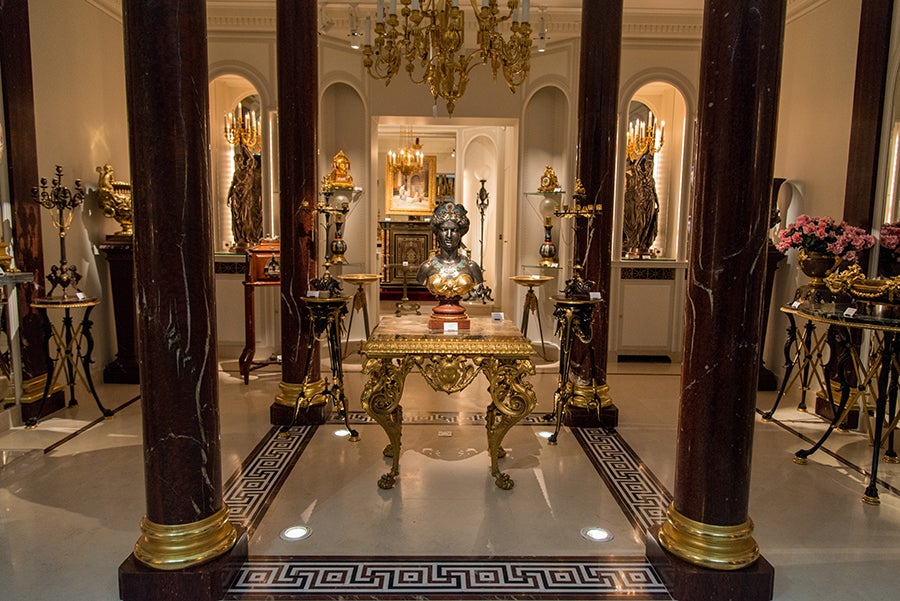
About the Seller
4.9
Vetted Seller
These experienced sellers undergo a comprehensive evaluation by our team of in-house experts.
Established in 1997
1stDibs seller since 2018
73 sales on 1stDibs
Typical response time: <1 hour
Associations
International Confederation of Art and Antique Dealers' Associations
- ShippingRetrieving quote...Ships From: PARIS, France
- Return PolicyA return for this item may be initiated within 7 days of delivery.
More From This SellerView All
- Pair of Neo-Greek Floor Lamps Att. to Lacarrière, Delatour & Cie, France, C 1860By Lacarrière, Delatour and Co.Located in PARIS, FRMeasures : Total Height : 188,5 cm (74,2 in.) ; Base : 45 x 45 cm (17,7 x 17,7 in.) Pedestal height : 136 cm (53,5 in.) Lamp height : 52 cm (20,4 in.) Beautiful pair of neo-Greek fl...Category
Antique 1860s French Greek Revival Floor Lamps
MaterialsGriotte Marble, Bronze
- Pair of Neo-Greek Andirons by F. Barbedienne, France, Circa 1870By Ferdinand BarbedienneLocated in PARIS, FRMeasures: Height : 47 cm (18,5 in.) ; Width : 70 up to 96 cm (27,5 – 37,8 in.) ; Depth : 6 cm (2,3 in.) A rare pair of square shaped andirons, made in gilded bronze and polychrome...Category
Antique 1870s French Greek Revival Fireplace Tools and Chimney Pots
MaterialsBronze, Enamel
- Pair of Neo-Greek Floor Lamps Attributed to G. Servant, France, Circa 1870By Georges Emile Henri ServantLocated in PARIS, FRRare pair of Greek style floor lamps made in patinated bronze attributed to G. Servant, each surmounted of a frosted glass globe engraved of stars and a Greek motif frieze. The body of the vase, decorated with Greek style patterns such as palmets, Greek motif frieze and water leaves, stands on a shaft decorated with deer heads. Fine chains are connected to a delicate butterfly. The set is based on tripod legs with lion claw feet alternating large palmets. Height : 183 cm (72 in.) ; 213 cm (83 3/4 in.) with glass shades ; Diameter : 43 cm (19 2/3in.) Georges Emile Henri Servant (1828-c.1890), who took over his father in 1855 at their foundry, rue Vieille-du-Temple, in Paris, specialized in the production of neo-Egyptian style clocks, very popular in France since 1860’s, and also the making of Greek style decorative objects. He drew considerable attention to the high quality of his bronzes at the 1855 Paris Universal Exhibition and then at the 1862 London Exhibition. At this time Servant exported up to 40% of his production, principally to the United States, where for instance, his clocks were sold with great success by Louis Tiffany Inc. or Hamann & Roche of New York. But his success came really at the 1867 Paris Universal Exhibition, where he was awarded a gold medal for his neo-Greek and Egyptian works (Les Merveilles...Category
Antique 1860s French Greek Revival Floor Lamps
MaterialsBronze
- Pair of Neo-Greek Amphora Vases by Barbedienne and Levillain, France, circa 1880By Ferdinand Levillain, Ferdinand BarbedienneLocated in PARIS, FRPair of Greek style vases made two patina bronze. Each, designed in the shape of a tripod amphora adorned with Hercules heads, is decorated in low-relief...Category
Antique 1880s French Greek Revival Vases
MaterialsGriotte Marble, Bronze
- Pair of Neo-Greek Wall-Lights Attributed to F. Barbedienne, France, Circa 1880By Ferdinand BarbedienneLocated in PARIS, FRA pair of neo-Greek wall-light sconces executed in two patina bronze attributed to F. Barbedienne. The central up-turned foliage stem, surmounted by a Greek style vase...Category
Antique 1880s French Greek Revival Wall Lights and Sconces
MaterialsBronze
- Large Neo-Greek Vase by F. Levillain & F. Barbedienne, France, circa 1890By Ferdinand Levillain, Ferdinand BarbedienneLocated in PARIS, FRImportant neo-Greek vase in the shape of an Amphora, made in two patina bronze. The body is decorated with a rich continuous frieze in bas-relief presenting a procession of characters carrying their offerings to the temple, underlined by a decoration of theatrical masks among olive trees. The 's'-scroll handles decorated with grape vines, resting only on the shoulder of the vase, are supported by a ram’s head. Numerous palmettes and friezes adorn the whole. Resting on a molded marble circular base. Biography Ferdinand Levillain (Paris, 1837-1905) studied under the sculptor Jouffroy (1806-1882), before making his debut in 1861 at the French Artists Salon where he continued to exhibit until 1903. At the 1867 Universal Exhibition in Paris, he was praised for a Neo-Greek style bronze cup he made for the firm Blot and Drouard. He was not to become really famous, however, until 1871 thanks to his association with the great bronze founder Ferdinand Barbedienne, who began to exhibit Neo-Greek style lamps...Category
Antique 1890s French Greek Revival Vases
MaterialsMarble, Bronze
You May Also Like
- Pair of Silvered Bronze Large Antique Floor Lamps, Attributed to BarbedienneBy Ferdinand BarbedienneLocated in London, GBThese beautiful antique French floor lamps are cast from delicate silvered bronze, and are decorated in the refined neoclassical style. The p...Category
Antique 19th Century French Neoclassical Floor Lamps
MaterialsBronze
- Pair of Gilt and Patinated Bronze Candelabra by Ferdinand BarbedienneBy Paul Dubois, Ferdinand BarbedienneLocated in Brighton, West SussexA Pair of Gilt and Patinated Bronze Figural Five-Light Candelabra Cast by Barbedienne after the Models by Alexandre Falguière and Paul Dubois. Signed ‘FALGUIERE’ and ‘P. DUBOIS’ ...Category
Antique 19th Century French Torchères
MaterialsBronze
- Pair of Large Patinated Bronze Figural Torcheres Cast by Barbedienne, Dated 1872By Émile Guillemin, Ferdinand BarbedienneLocated in Brighton, West SussexA highly important pair of large patinated bronze figural torcheres by Émile Guillemin, cast by Ferdinand Barbedienne. French, dated 1872. Barbedienne Title: 'Deux Femmes, Indi...Category
Antique Late 19th Century French Floor Lamps
MaterialsBronze
- Pair, Bronze Floor Lamps in Acanthus Leaf DesignLocated in Summerland, CADramatic pair of floor lamps. Base support is tripod acanthus leaf motif in heavy cast bronze. Contrasted to the simple, elegant posts also in bronze. Beautifully verdigris finish. S...Category
Vintage 1960s Italian Greek Revival Floor Lamps
MaterialsBronze
- Pair of Bronze Floor LampsLocated in New York, NYPair of 1940s Italian large patinated bronze torcheres with original patina. Three interior Edison lights each.Category
Vintage 1940s Italian Floor Lamps
- Pair of Bronze Floor Lamps by Cedric HartmanBy Cedric HartmanLocated in Atlanta, GADesigned in 1978 by Cedric Hartman (American, Omaha, NE, 1929), this model "91 CO" floor lamp, features a brushed bronze finish. Heavy base for stability, the lamp is adjustable with...Category
Vintage 1970s American Modern Floor Lamps
MaterialsBronze, Chrome
Recently Viewed
View AllMore Ways To Browse
Stiffel Floor Lamp Brass Gold Shade
Octopus Floor Lamp
Pyppe Floor Lamp
Raymond Sube Iron
Rl Lamps
Stifel Lamps
Stiffel Lamps Tension
Stiffel Tension
Teak Arch Floor Lamp
Teak Floor Lamp Onion
Tempestini Floor Lamp
Tiffany Studios 423
Tony Paul Floor Table Lamp
Torres Clave
Turned Wood Ornaments
Valenti Adnet
Victorian Retro Floor Lamps
Victorian Wicker Floor Lamp
